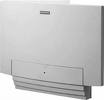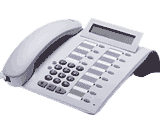

ÔçëåöùíéêÜ ÊÝíôñá hipath 3250 siemens
The Siemens HiPath 3250 is a small system for ISDN lines only. Its initial configuration is for 2 ISDN2e lines (4 channels), 4 digital & 4 analogue extensions. It is possible to add a further 4 extensions using optiPoint adaptors.


Features
System features
The HiPath 3250/3150 system offers a wide range of features.
Selected features
l
Caller list. Unanswered internal and externalcalls are recorded on system
telephones with a display if external calls
contain a directory number (ISDN) and
internal calls are transmitted with the
caller’s name. The calls are entered in a
list with a date and time stamp and the
number of call attempts is recorded. A
callback can be initiated directly from
this list.
l
Do-not-disturb/”silent call”. Users canblock incoming calls. Callers hear the
busy signal when “do-not-disturb” has
been activated. Authorized users (attendants,
for example) can override this
feature. Acoustic signaling of calls can be
deactivated on system telephones so
they are only indicated on the display.
l
Call pickup. Calls can be picked up onusers’ own telephones within a call pickup
group or selectively for specific
colleagues.
l
Override. Authorized stations can intrudeon other users’ calls in progress.
l
Classes-of-service Different access authorizationscan be assigned to each
user, with a distinction being made
between
– full toll access
– partial toll access
– no toll access
l
Broadcast intercom call to system telephonesor over external loudspeakers (in
a waiting room, for instance)
l
Call cost logging for each terminal oreach trunk in the summation memory.
Call duration display is used for analog lines
without call charge pulses.
l
Group call For groups of up to 8 users.Individual stations can temporarily leave
the group.
l
Line keys (MULAP)The following flexible setups are possible
with line keys:
– teams,
– executive/secretary functions,
– feature handset (gigaset) in parallel
with an optiset E telephone on a single
directory number (only in conjunction
with HiPath cordless).
l
Internal telephone book. All extensionsare stored with their associated names in
the system’s internal telephone book.
They can be searched and dialed directly
via the display on system telephones.
l
Speed dialing individual/system. Forall services it is possible to store up to 10
destinations on each telephone individually
and up to 300 destinations centrally
in the system.
l
Toggling between two existingconnections
l
Text messages. You can send users predefined(e.g. “Visitor waiting”) or personal
short messages (optiset E memory
only) via the display.
l
Internal texts to the feature handset.When HiPath cordless is used it is also
possible to send internal text messages
to the feature handset.
l
Advisory messages can be left on yourown telephone (e.g. Back at:....).
l
Project code. Telephone costs can be assignedto a specific procedure or project
by entering the project code (max. 11
digits).
l
Call number suppression. With ISDNconnections, callers can suppress the
display of their directory number on the
called party’s terminal either on a crosssystem
basis or temporarily.
l
Distinctive call signaling for internalcalls, external calls, recalls, and callback
calls
l
Add-on ringing. Call signaling simultaneouslyat several telephones
l
Connection for door interface. Callsfrom the entrance telephone can even
be routed to an external destination by
using external call forwarding
l
Automatic redial (expanded) for thelast three external call numbers